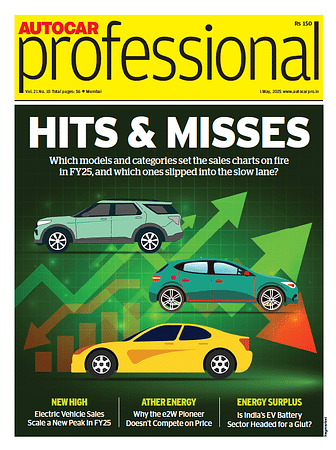Request govt to reduce polluting vehicles and ban 15 year old vehicles: Vinod Dasari, President, SIAM
In his keynote address, he alluded to the Automotive Mission Plan 2026 which aims to propel India into the top three markets in the world for engineering, manufacture and export of vehicles and components, and will encompass safe, efficient, environment-friendly conditions for affordable mobility of people and transportation of goods, comparable with global standards, growing in value to over 12 percent of India’s GDP and generating an additional 65 million jobs.
Vinod Dasari, president, Society of Indian Automobile Manufacturers (SIAM) in his last address as head of SIAM at the 57th SIAM Annual Convention, has asked the government to reduce polluting vehicles and ban 15 year old vehicles. He believes Indian auto industry at the threshold of major transformation, unprecedented challenges.
Vinod Dasari is also the CEO and MD, Ashok Leyland, as well as Automotive Research Association of India (ARAI), In his previous keynote address at The Automotive Forum on ‘Growth Through Smarter Manufacturing and Simulation’, held by Autocar Professional on June, 7, 2017 he had set the tone for the seminar with his lively keynote address – ‘Charting the growth curve for Indian companies in a new automobile world’.
Dasari began by saying that Indian manufacturing has performed exceedingly well over the long term, growing steadily at a CAGR of 13 percent over 25 years. He said, India’s growth is superior to other economies and sectors excepting China. “India is among the fastest growing economies in the world and the auto industry is a big contributor.”
Detailing this, he said the Indian automotive industry contributes to nearly 50 percent of manufacturing GDP and also generates significant employment. Of the combined industry turnover of Rs 880,000 crore ($140 billion) in FY2016, the OE industry’s turnover was Rs 625,000 crore ($100 billion) and the component sector’s Rs 255,000 crore (S40 billion). While OEMs’ contribute 7.1 percent to GDP, parts makers’ share is 4 percent. Over 32 million people are employed by Indian Auto Inc — 2 million as direct employment and 30 million as indirect employment. Importantly, he said, India is today a globally competitive manufacturing base for exports.
Commenting on how increased personal consumption is driving growth, he said in India, value-driven consumers have driven industry to be very cost-competitive. Dasari, who exhorted engineers to leverage change in the auto industry by driving innovation, said “There is no need to cut and paste technology from Europe. Leverage change with Indian innovation. This is the era of India. Engineers should not look to the West for ideas, instead, develop your very own solutions tailored to the Indian market.”
Dasari also pointed out that India Auto Inc also needs to think of Design in India in addition to Make In india. Global automakers should use India as a design hub and not only as a manufacturing hub.
In his keynote address, he alluded to the Automotive Mission Plan 2026 which aims to propel India into the top three markets in the world for engineering, manufacture and export of vehicles and components, and will encompass safe, efficient, environment-friendly conditions for affordable mobility of people and transportation of goods, comparable with global standards, growing in value to over 12 percent of India’s GDP and generating an additional 65 million jobs.
Dasari spoke about the substantial — also termed disruptive — changes underway in manufacturing. He cited the big cost decreases in the past decade in processing power (50x), bandwidth (40x), data storage (20x, per MB), sensors (by 50%) and robots (by 25%). The expected areas of disruptive change, in his opinion,will be Industry 4.0, big data, analytics and telematics, autonomous robots, 3D printing, augmented reality and simulation.
Dasari spoke about how Ashok Leyland has made the leap towards being a data-driven organisation and has developed a comprehensive suite of analytical tools for sales, service, warranty and dealer viability. The company has successfully merged data with telematics and come up with the i-Alert vehicle tracking software.
Dasari said autonomous vehicles will come to India, albeit a little late. Speaking about robot density, he said India, with less than 30 robots per 10,000 employees, lags behind the developed world’s average robot density of 69 per 10,000 employees. He said, China plans to have an average of 150 robots per 10,000 staffers by the year 2025.
Summing up, he said the present time is India’s chance to drive change in the manufacturing world which it can by leveraging innovation.
RELATED ARTICLES
Bajaj Auto launches new Chetak 3503 at Rs 110,000
The Chetak 3503, with a claimed range of 155km, 63kph top speed and a slower charging time than its 35 Series siblings, ...
Hyundai walks the eco talk with biogas plant, material recovery plant in Gurugram
Operational since October 2022, the facility targets sustainable waste management in Gurugram by undertaking scientific ...
Rajiv Bajaj reappointed MD and CEO of Bajaj Auto for five-year term
Bajaj Auto’s Board of Directors has approved the re-appointment of Rajiv Bajaj as the company’s MD and CEO for another f...






 07 Sep 2017
07 Sep 2017
 4679 Views
4679 Views





 Autocar Professional Bureau
Autocar Professional Bureau




